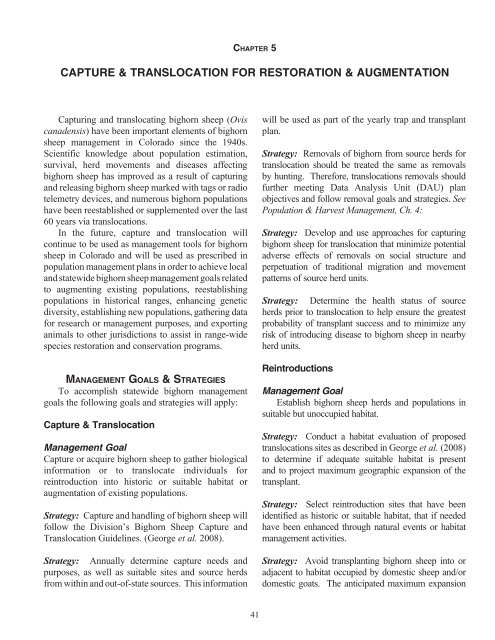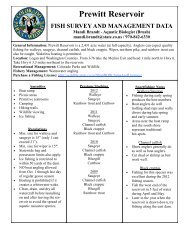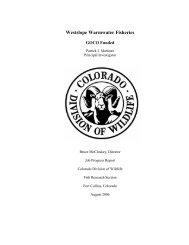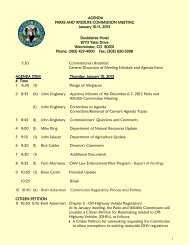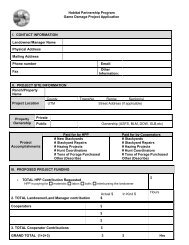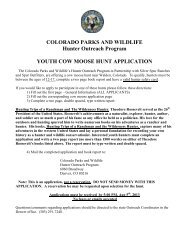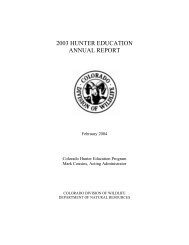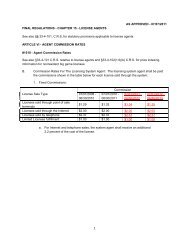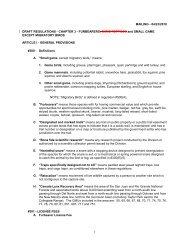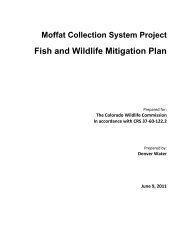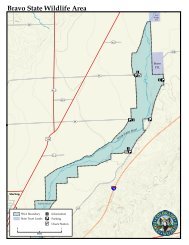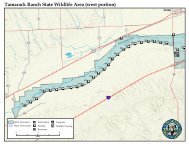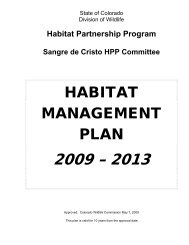COLORADO BIGHORN SHEEP MANAGEMENT PLAN 2009−2019
COLORADO BIGHORN SHEEP MANAGEMENT PLAN 2009−2019
COLORADO BIGHORN SHEEP MANAGEMENT PLAN 2009−2019
You also want an ePaper? Increase the reach of your titles
YUMPU automatically turns print PDFs into web optimized ePapers that Google loves.
Chapter 5<br />
CAPTURE & TRANSLOCATION FOR RESTORATION & AUGMENTATION<br />
Capturing and translocating bighorn sheep (Ovis<br />
canadensis) have been important elements of bighorn<br />
sheep management in Colorado since the 1940s.<br />
Scientific knowledge about population estimation,<br />
survival, herd movements and diseases affecting<br />
bighorn sheep has improved as a result of capturing<br />
and releasing bighorn sheep marked with tags or radio<br />
telemetry devices, and numerous bighorn populations<br />
have been reestablished or supplemented over the last<br />
60 years via translocations.<br />
In the future, capture and translocation will<br />
continue to be used as management tools for bighorn<br />
sheep in Colorado and will be used as prescribed in<br />
population management plans in order to achieve local<br />
and statewide bighorn sheep management goals related<br />
to augmenting existing populations, reestablishing<br />
populations in historical ranges, enhancing genetic<br />
diversity, establishing new populations, gathering data<br />
for research or management purposes, and exporting<br />
animals to other jurisdictions to assist in range-wide<br />
species restoration and conservation programs.<br />
ManageMent goals & strategies<br />
To accomplish statewide bighorn management<br />
goals the following goals and strategies will apply:<br />
Capture & Translocation<br />
Management Goal<br />
Capture or acquire bighorn sheep to gather biological<br />
information or to translocate individuals for<br />
reintroduction into historic or suitable habitat or<br />
augmentation of existing populations.<br />
Strategy: Capture and handling of bighorn sheep will<br />
follow the Division’s Bighorn Sheep Capture and<br />
Translocation Guidelines. (George et al. 2008).<br />
Strategy: Annually determine capture needs and<br />
purposes, as well as suitable sites and source herds<br />
from within and out-of-state sources. This information<br />
41<br />
will be used as part of the yearly trap and transplant<br />
plan.<br />
Strategy: Removals of bighorn from source herds for<br />
translocation should be treated the same as removals<br />
by hunting. Therefore, translocations removals should<br />
further meeting Data Analysis Unit (DAU) plan<br />
objectives and follow removal goals and strategies. See<br />
Population & Harvest Management, Ch. 4:<br />
Strategy: Develop and use approaches for capturing<br />
bighorn sheep for translocation that minimize potential<br />
adverse effects of removals on social structure and<br />
perpetuation of traditional migration and movement<br />
patterns of source herd units.<br />
Strategy: Determine the health status of source<br />
herds prior to translocation to help ensure the greatest<br />
probability of transplant success and to minimize any<br />
risk of introducing disease to bighorn sheep in nearby<br />
herd units.<br />
Reintroductions<br />
Management Goal<br />
Establish bighorn sheep herds and populations in<br />
suitable but unoccupied habitat.<br />
Strategy: Conduct a habitat evaluation of proposed<br />
translocations sites as described in George et al. (2008)<br />
to determine if adequate suitable habitat is present<br />
and to project maximum geographic expansion of the<br />
transplant.<br />
Strategy: Select reintroduction sites that have been<br />
identified as historic or suitable habitat, that if needed<br />
have been enhanced through natural events or habitat<br />
management activities.<br />
Strategy: Avoid transplanting bighorn sheep into or<br />
adjacent to habitat occupied by domestic sheep and/or<br />
domestic goats. The anticipated maximum expansion


